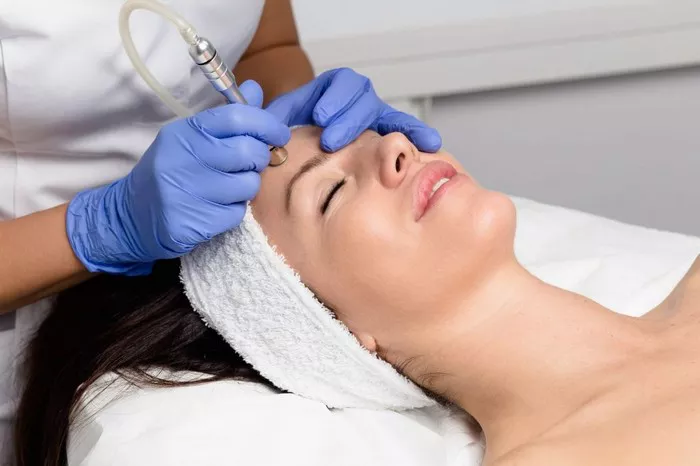Microdermabrasion is a popular cosmetic procedure that has gained prominence in recent years for its ability to rejuvenate and improve the appearance of the skin. This non-invasive treatment offers a range of benefits by addressing various skin concerns and promoting a smoother, more youthful complexion. In this article, we will explore the potential advantages of microdermabrasion for your skin, the science behind the procedure, and the factors to consider before undergoing treatment.
Understanding Microdermabrasion
Microdermabrasion is a skin exfoliation technique that involves the removal of the outermost layer of dead skin cells using a specialized device. This process encourages the skin’s natural healing response, stimulating collagen production and revealing fresher, healthier skin underneath. The procedure is typically performed by a trained aesthetician or dermatologist and is suitable for a wide range of skin types.
Benefits of Microdermabrasion for Your Skin
Microdermabrasion offers a host of potential benefits for your skin, making it a versatile treatment option. Here are some key advantages:
Exfoliation: The primary benefit of microdermabrasion is its exfoliating effect. By gently removing the outer layer of dead skin cells, microdermabrasion reveals smoother, more vibrant skin. This process also promotes cell turnover, which can improve skin texture and tone.
Reduction of Fine Lines and Wrinkles: Microdermabrasion stimulates collagen production, a protein responsible for skin’s firmness and elasticity. Increased collagen levels can help reduce the appearance of fine lines and wrinkles, making the skin look plumper and more youthful.
Minimization of Pores: Enlarged pores can give the skin an uneven texture. Microdermabrasion can help unclog and minimize pores, leading to a smoother complexion.
Treatment of Hyperpigmentation: Microdermabrasion can be effective in reducing the appearance of hyperpigmentation, such as age spots, sun spots, and mild acne scars. By removing the top layer of pigmented skin, the treatment can promote a more even skin tone.
Enhanced Absorption of Skincare Products: Exfoliated skin is better able to absorb skincare products. After microdermabrasion, your skincare routine can be more effective as products penetrate the skin more deeply.
Improved Blood Circulation: The mechanical exfoliation involved in microdermabrasion can boost blood circulation to the treated area. Improved circulation brings oxygen and nutrients to the skin, contributing to a healthier complexion.
Reduction of Mild Acne and Blemishes: Microdermabrasion can help clear clogged pores and remove the outer layer of dead skin cells, reducing the likelihood of acne breakouts and improving the appearance of blemishes.
Enhanced Skin Texture: The exfoliating action of microdermabrasion can lead to a smoother skin texture. This is particularly beneficial for those with rough or uneven skin.
The Science Behind Microdermabrasion
Microdermabrasion works by utilizing two primary methods: crystal-based and diamond-tipped. In the crystal-based method, a device sprays fine crystals onto the skin’s surface to exfoliate it, while a vacuum simultaneously removes the crystals and exfoliated skin cells. The diamond-tipped method employs a handpiece with a diamond-tipped wand that physically exfoliates the skin, and a vacuum system removes the exfoliated cells.
Both methods result in the removal of the outermost layer of dead skin cells, stimulating the skin’s healing response. This response includes the production of new skin cells and collagen, which contribute to the rejuvenation and improvement of the skin’s appearance.
Factors to Consider Before Treatment
Before undergoing microdermabrasion, there are several factors to consider:
Skin Sensitivity: If you have highly sensitive or delicate skin, it’s important to discuss your concerns with a skincare professional before undergoing treatment. They can tailor the treatment to your skin’s needs to avoid irritation.
Skin Conditions: Individuals with certain skin conditions, such as active acne, eczema, or rosacea, may need to avoid or modify microdermabrasion to prevent exacerbating their condition. Consulting a dermatologist is advisable in such cases.
Frequency of Treatments: While microdermabrasion is non-invasive, multiple sessions are often recommended to achieve desired results. The frequency of treatments depends on your skin’s condition and your skincare goals.
Aftercare and Sun Protection: Following microdermabrasion, your skin will be more sensitive to the sun. It’s essential to use sunscreen and avoid excessive sun exposure to protect your newly exfoliated skin.
Expectations: While microdermabrasion offers noticeable improvements, it’s important to have realistic expectations. Results can vary depending on individual skin conditions and factors.
Qualified Professionals: Seek treatment from licensed and experienced aestheticians or dermatologists who are skilled in performing microdermabrasion.
Conclusion
Microdermabrasion is a versatile and effective cosmetic procedure that can offer numerous benefits for your skin. By promoting exfoliation, collagen production, and skin renewal, microdermabrasion addresses various concerns such as fine lines, wrinkles, uneven skin tone, and more. If you’re considering microdermabrasion, it’s crucial to consult with a qualified skincare professional who can assess your skin’s needs and recommend the most suitable treatment plan. With proper care and attention, microdermabrasion can help you achieve smoother, healthier, and more youthful-looking skin.


